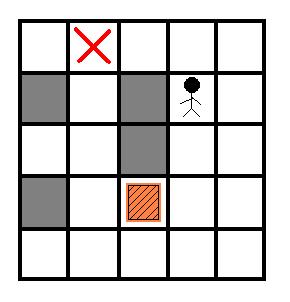hdu1254 推箱子(bfs+bfs)
2015-10-23 18:54
302 查看
推箱子
Time Limit: 2000/1000 MS (Java/Others) Memory Limit: 65536/32768 K (Java/Others)Total Submission(s): 6386 Accepted Submission(s): 1825
[align=left]Problem Description[/align]
推箱子是一个很经典的游戏.今天我们来玩一个简单版本.在一个M*N的房间里有一个箱子和一个搬运工,搬运工的工作就是把箱子推到指定的位置,注意,搬运工只能推箱子而不能拉箱子,因此如果箱子被推到一个角上(如图2)那么箱子就不能再被移动了,如果箱子被推到一面墙上,那么箱子只能沿着墙移动.
现在给定房间的结构,箱子的位置,搬运工的位置和箱子要被推去的位置,请你计算出搬运工至少要推动箱子多少格.

[align=left]Input[/align]
输入数据的第一行是一个整数T(1<=T<=20),代表测试数据的数量.然后是T组测试数据,每组测试数据的第一行是两个正整数M,N(2<=M,N<=7),代表房间的大小,然后是一个M行N列的矩阵,代表房间的布局,其中0代表空的地板,1代表墙,2代表箱子的起始位置,3代表箱子要被推去的位置,4代表搬运工的起始位置.
[align=left]Output[/align]
对于每组测试数据,输出搬运工最少需要推动箱子多少格才能帮箱子推到指定位置,如果不能推到指定位置则输出-1.
[align=left]Sample Input[/align]
1
5 5
0 3 0 0 0
1 0 1 4 0
0 0 1 0 0
1 0 2 0 0
0 0 0 0 0
[align=left]Sample Output[/align]
4
[align=left]Author[/align]
Ignatius.L & weigang Lee
分析:bfs嵌套bfs,一个搜人的轨迹,一个搜箱子的轨迹。
#include <iostream>
#include <cstdio>
#include <cstring>
#include <stack>
#include <queue>
#include <map>
#include <set>
#include <vector>
#include <cmath>
#include <algorithm>
using namespace std;
const double eps = 1e-6;
const double pi = acos(-1.0);
const int INF = 0x3f3f3f3f;
const int MOD = 1000000007;
#define ll long long
#define CL(a,b) memset(a,b,sizeof(a))
int n,m;
int mat[11][11],dir[4][2]= {{0,1},{0,-1},{1,0},{-1,0}};
bool vis[11][11][4],vm[11][11];
int man_x,man_y,box_x,box_y,en_x,en_y;
struct A
{
int x,y;
};
struct node
{
int step;
struct A box,man;
};
bool bb(int b_x, int b_y, int m_x, int m_y, int k)//搜人是否能到达要推的位置
{
CL(vm, false);
queue<node> qq;
node ss,tt;
ss.man.x=m_x;
ss.man.y=m_y;
vm[ss.man.x][ss.man.y]=true;
vm[b_x][b_y]=true;//当前箱子的位置标记不可访问
qq.push(ss);
while(!qq.empty())
{
ss=qq.front();
qq.pop();
if(ss.man.x+dir[k][0]==b_x&&ss.man.y+dir[k][1]==b_y) return true;
for(int i=0; i<4; i++)
{
tt.man.x=ss.man.x+dir[i][0];
tt.man.y=ss.man.y+dir[i][1];
if(mat[tt.man.x][tt.man.y]!=0) continue;
if(!vm[tt.man.x][tt.man.y])
{
vm[tt.man.x][tt.man.y]=true;
qq.push(tt);
}
}
}
return false;
}
void bfs()//搜箱子的轨迹
{
queue<node> q;
node now,next;
now.box.x=box_x;
now.box.y=box_y;
now.man.x=man_x;
now.man.y=man_y;
now.step=0;
q.push(now);
while(!q.empty())
{
now=q.front();
q.pop();
if(now.box.x==en_x&&now.box.y==en_y)
{
cout<<now.step<<endl;
return ;
}
for(int i=0; i<4; i++)
{
next.box.x=now.box.x+dir[i][0];
next.box.y=now.box.y+dir[i][1];
//cout<<bb(now.box.x, now.box.y, now.man.x, now.man.y, i)<<endl;
if(vis[next.box.x][next.box.y][i]||mat[next.box.x][next.box.y]!=0) continue;
if(bb(now.box.x, now.box.y, now.man.x, now.man.y, i))//如果人能走到推箱子的位置
{
vis[next.box.x][next.box.y][i]=true;
next.man.x=now.box.x;//人推箱子后的位置变为之前箱子的位置
next.man.y=now.box.y;
next.step=now.step+1;
q.push(next);
}
}
}
cout<<"-1"<<endl;
}
int main()
{
int T;
cin>>T;
while(T--)
{
CL(mat, -1);//地图初始化,边界全为-1
cin>>n>>m;
for(int i=1; i<=n; i++)
{
for(int j=1; j<=m; j++)
{
cin>>mat[i][j];
if(mat[i][j]==2)//人、箱子和终点的位置存储好,再把地图中相应位置变为可走,即0
{
box_x=i;
box_y=j;
mat[i][j]=0;
}
if(mat[i][j]==3)
{
en_x=i;
en_y=j;
mat[i][j]=0;
}
if(mat[i][j]==4)
{
man_x=i;
man_y=j;
mat[i][j]=0;
}
}
}
CL(vis, false);
bfs();
}
return 0;
}
相关文章推荐
- iOS开发 -- main.m文件解析
- Softmax回归(Softmax Regression)
- 数据你把它的金额-JAVA分页
- 练习2 I题 - 水仙花数
- Android沉浸式状态栏、导航栏
- iOS开发 -- SVN的使用
- 如何向以json对象为元素的数组中追加一个新的元素
- C++ 二叉树
- 求解素数-埃拉托斯特尼筛法
- jquery的ajax同步和异步
- APK反编译各工具下载集合
- JQuery+ajax实现类似百度搜索自动匹配功能
- ZOJ(Modular Inverse)——最小乘法逆元
- 佟刚老师《Spring4视频教程》学习笔记(1)--转载
- ffmpeg AVFrame 插入静音帧
- 软件测试工程师
- Oracle 11.2.0.4 动态监听不注册
- 原生和html比较
- 问题--[__NSCFNumber length]: unrecognized selector sent to instance 0x8b3c310’ - andy_shen
- python copy 深拷贝与浅拷贝
